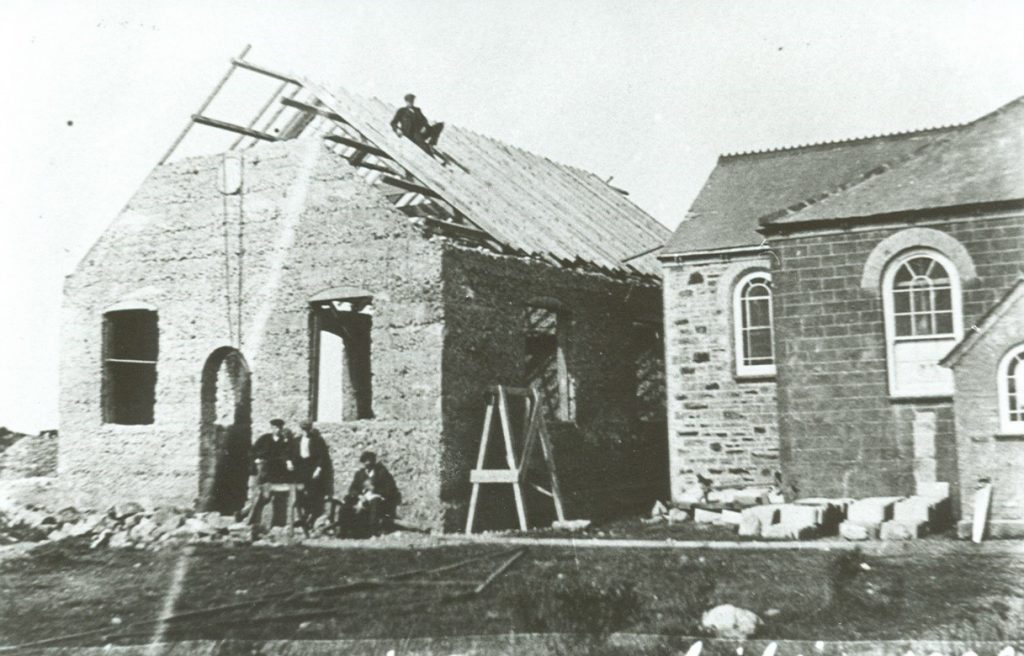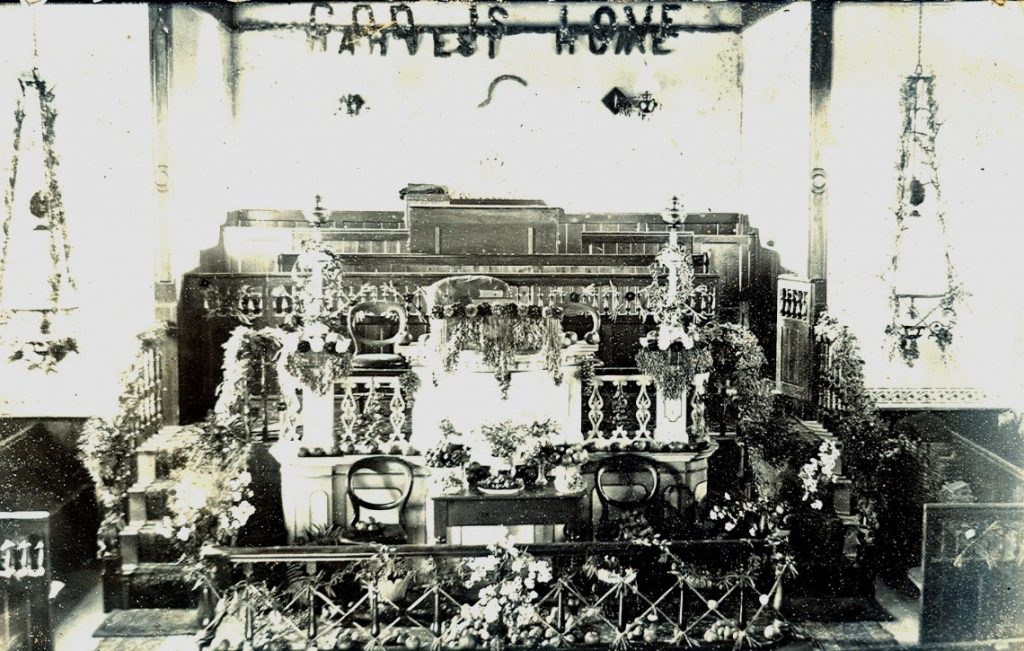
Crosscoombe is a scattered community near Trevellas, in St Agnes parish. This profile of Cross Coombe Primitive Methodist Chapel has been compiled by Clive Benney & Tony Mansell.
A Primitive Methodist chapel and Sunday school is recorded on the 1st and 2nd Edition 1:2500 1880 and 1907 OS Maps. It was demolished to make way for RAF Perranporth in 1939. (Cornwall Heritage Gateway)
1835: Society seems to have been formed with a membership of 20.
1836: Membership had increased to 60.
1836: Chapel with a capacity of 210 being built. The choir sat behind the pulpit and at the back of the chapel the seats rose steeply, to accommodate a classroom below.
1884: Redecorated internally and completely refurnished with new pews, a new rostrum and an American organ.
 Circa 1906 – Crosscoombe Primitive Methodist Chapel demolished in 1943 to make way for RAF Perranporth runway extension – William Isaac Grigg stands by the porch and the Minister outside the gate. (Photo: courtesy Clive Benney)
Circa 1906 – Crosscoombe Primitive Methodist Chapel demolished in 1943 to make way for RAF Perranporth runway extension – William Isaac Grigg stands by the porch and the Minister outside the gate. (Photo: courtesy Clive Benney)
1907 – 13th July: Crosscoombe Sunday School tea-treat procession headed by the banner carriers and Bugle Brass Band. The procession marched down London Lane to Menadue’s Shop where the band played and hymns were sung. From there they marched through Trevellas and out to Lavender Cottage (top of Coombe Road) where they turned and retraced their steps back to Trevellas as seen in the photo. The tea-treat was held in Mr Berryman’s field and the weather was glorious all day and evening. (Photo: courtesy Clive Benney)
1908: Sunday school built. Members of the congregation provided the labour to build it but the carpentry work was let to local carpenter and undertaker, Frank Piper.
 Crosscoombe Sunday school being built (Photo: courtesy Clive Benney)
Crosscoombe Sunday school being built (Photo: courtesy Clive Benney)
Frank Piper was awarded the contract to build the Sunday school and he was assisted by Edward Opie of Harmony Cot. Volunteer labour was used to construct the insitu-concrete walls. The concrete was mixed on site using pebbles brought up from the beach. Timber formwork or shuttering would have been positioned and the concrete poured in layers until the required height was reached. (“Jericho to Cligga” by Clive Benney and Tony Mansell)
 1908 Harvest Festival (Photo: courtesy Clive Benney)
1908 Harvest Festival (Photo: courtesy Clive Benney)
1927: New organ purchased from Heard & Sons of Boscawen Street, Truro.
1932: The Wesleyan, Primitive Methodist and the United Methodist Church amalgamated to become the Methodist Church of Great Britain.
The Chapel was very active and it was a great shock to the members when they were told that the buildings were to be demolished to accommodate RAF Perranporth runway extension.
Crosscoombe tea treats were great days and according to Ruth Jennings, “The Sunday school pupils, teachers and families met at the chapel at two o’clock and after a short service, formed a procession headed by a brass band, usually from St Agnes. The Sunday school paraded from the chapel to Trevellas post office where we sang a hymn before turning to parade up through the village, past the blacksmith’s shop opposite the Men’s Institute, along as far as the top of Harmony Cot road to Lavender Cottage, the home of the Hooper family. Returning to Crosscoombe Chapel, and a field lent by Mr Mitchell, where the traditional saffron buns and mugs of tea were served to the children. There, the ladies of the chapel were waiting to serve the public at the tables very beautifully laid with cakes and buttered splits and so on, all on lovely white tablecloths and the best bone china and silver teapots and hot water jugs. The water was always boiled on a fire by a man employed as a stoker. There would also be a stall of fruit and sweets provided by Jack Letcher and, after his death, by his son, Johnnie Letcher.”
Richie Sandercock recalled 1938 when St Agnes Band played at Crosscoombe tea treat. “We marched from the chapel to Zion House and then down London Lane to where it met the Perranporth to St Agnes road. We turned right and went up the hill into Trevellas where we turned right again at the men’s institute and headed back for Zion House and the chapel (the route had been somewhat longer in previous years). My brothers Bill and John were also in the band. It was a full-day event and we always finished tea treats with the Serpentine Walk.”
1939: “Crosscombe Methodist Sunday school treat was held in July when teachers and scholars, headed by the St Agnes Silver Band, paraded the village. On returning to the school the children were provided with buns. A public tea was served …” (20 July 1939 – West Briton and Cornwall Advertiser)
1940: Seating for 152, (David Easton, Methodist Minister and historian)
1941: Chapel closed.
1941: The congregation joined the Wesleyans at Trevellas Downs Chapel. All the interior fittings, including the organ, were used there.
1942: Crosscoombe Chapel and Sunday school demolished to make way for airfield extension. (Revd David Easton)
1956: The Primitives’ fittings and organ transferred from Trevellas Downs Wesleyan Chapel to the new Trevellas and Crosscoombe Chapel.
l.
